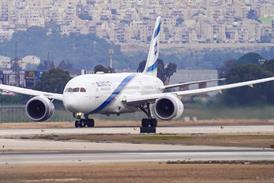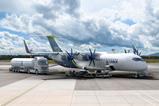RTX companies Pratt & Whitney and Collins Aerospace continue to examine how they could take a hybrid-electric version of the PW1100G engine to flight test even as they prepare to build the first ground-test demonstrator.
Collaborating through the MTU Aero Engines-led SWITCH consortium, the pair have been working to add 1MW-class motor-generators to the geared turbofan’s high- and low-speed spools to boost efficiency.

All the electrical elements for the demonstrator will be brought together in The Grid, RTX’s advanced electric power systems lab in Rockford, Illinois, in the second half of the year, ahead of installation of the motors onto the PW1100G in 2026, says Todd Spierling, principal technical fellow, electrification, at Collins Aerospace.
Full engine tests will then take place later that year at EME Aero in Jasionka, Poland as the first phase of the SWITCH project concludes.
Funded by the EU’s Clean Aviation body, the SWITCH consortium also includes GKN Aerospace – which recently delivered the high-voltage electrical wiring harnesses for the project – and, crucially, Airbus, which has been examining the integration challenges of a hybrid-electric engine.
The airframer’s involvement has been a key part of the project, says Spierling as “You need to make decisions about where to put certain components of the propulsion system.”
“There has been lots of work on the physical implementation and what that looks like,” he adds, as well as how the propulsion system “fits into the broader context of the airplane”.
Considerations for Airbus include the thermal management of the airframe, the routing of wiring and any protection needed, he says, essentially working out “how do we safely move that 800V through the wing and fuselage.”
Additionally, failure modes or redundancies on the powerplant are different to those on a conventional engine, Spierling says.
Airbus has also contributed to the overall system architecture, its optimisation “and what the configuration looks like”, says Kristin Smith, vice-president electric power systems, Collins Aerospace.
“There are lots of learnings that are coming out of this that really enables us to optimise the architecture.”
While the first part of SWITCH ends in 2026, the consortium members are already eyeing a possible follow-on phase that would likely take to the engine to flight test, a point where Airbus’s input will prove vital.
“We have always been looking at the end to be able to fly it,” says Spierling.
However, this would require further Clean Aviation funding and is dependent on a request for proposals likely to be released in early 2026 as part of the programme’s fourth call.
“We are really excited and hopeful that the EU approves funding for that because it would be a meaningful and product-ready technology that could be accelerated if it is available,” says Dr Michael Winter, RTX chief scientist.
It is not clear at this stage if Airbus would form part of the SWITCH consortium for the follow-on phase but there are a limited number of airframe partners in Europe that could potentially contribute flight-test assets.
At its outset, SWITCH sought to marry two distinct technologies into a ground demonstrator: a hybrid-electric system and the Water Enhanced Turbofan being developed by MTU.
But following the German propulsion specialist’s decision earlier this year to abandon the WET research, SWITCH will also adapt, instead incorporating “some aerodynamic changes” and “enhancements to the thermodynamic cycle”.
Winter declines to provide specifics but says “we are likely to bring them forward in our phase-two activities in Clean Aviation”.
With Airbus in the early stages of analysing its options for its A320-replacing next-generation single-aisle, all three big engine makers – CFM International, P&W, and Rolls-Royce – are preparing future engine technologies.
But while CFM is beating heavily on an open-rotor concept, P&W and Rolls-Royce are both extolling the benefits of a next-generation ultra-high-bypass-ratio ducted fan engine.
Winter sees benefits from the open-fan architecture but highlights integration challenges such as the need to “add mass to protect the fuselage” from a blade release.
“And if you have a thin wing with laminar flow – if you put an egg-beater in front of that it’s not going to preserve that nice smooth airflow,” he adds.































